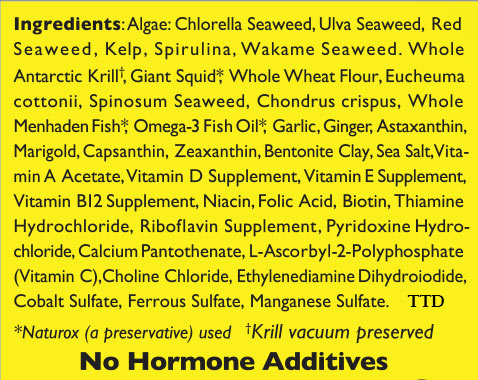Regarding water content, just a couple of examples. For most fish foods, the guaranteed analysis between the frozen version, and the freeze dried version, of a
single unit (in the first example a single mysis) will be identical, the only real difference is that one will have 98% of its moisture removed.
When you dehydrate or freeze dry a food, it will shrink in size, but the protein/fat content remains the same. The only thing that changes is the amount of moisture, so one needs to be careful so as not to overfeed a freeze dried product (because it appears much smaller) than the same food in its original or frozen state.
So
ounce for ounce a fish will glean far more protein out of a dry food, than they would the same amount (per ounce) of a frozen product, due the majority of the weight from a frozen food being from the high moisture content. The same applies to most pellets as most dry food products have approx. 10% moisture content (or less).
Water is a non nutrient, so while it may help increase palatability, and possibly aid in digestion, it will also make a fish reach satiation much quicker then if fed dry food. It's like drinking a couple of glasses of water, before you sit down for your platter of surf & turf. You won't be nearly as hungry. Probably a good thing for those that overfeed by large amounts, but not such a good thing for those that tend to under feed.
The following Nutritional analysis provided by Piscine Energetics (PE Mysis)
Frozen Mysis
Protein 10.46
Crude Fat 3.29
Moisture 82.27
Ash 1.65
Carbohydrates (by subtraction) 2.3
Guaranteed Analysis from dry weight (freeze dried)
Min Crude Protein 69.5%
Min Crude Fat 8.35%
Max Crude Fiber 2.75%
Max Ash 5.5%
Another example.
A typical analysis of freeze dried bloodworms.
Guaranteed Analysis
Min. Crude Protein...55%
Min. Crude Fat.....3%
Max. Crude Fiber.....5%
Max. Moisture..... 5%
A typical analysis of frozen bloodworms. (from the same manufacturer as above)
Guaranteed Analysis
Min. Crude Protein..........6.3%
Min. Crude Fat............... 0.8%
Max. Crude Fiber........... 0.3%
Max. Moisture.......91.2%
Approximate analysis of earthworms was completed by Dr. Carl Cater in the Oilseed Products Laboratory at Texas A&M. He reported that on the samples tested moisture (volatile) averaged 80.44%. A further analysis of freeze-dried earthworms indicated the following components: oil 6.8-7.1%, nitrogen 10.6 - 11.0%, protein 66.2 - 68.6% and ash 9.3 - 9.7%. This would indicate that on whole, live earthworms are less than 14% protein. Therefore its use as food or a feed supplement would probably be limited.
This is something that I attempted to explain when Repashy first hit the market several years ago. Some people got it, and some I reckon aren't so good at math.
I came across this product on Ted Judy's YouTube channel. I've always found his videos extremely informative and he is an excellent hobbyist but i can't say I've ever seen him endorse a product like this before. Repashy is a gelatin based food which comes in powder form. As you will see in Ted's...

www.monsterfishkeepers.com
To which the owner, Allen Repashy, never did answer the following question;
Can you please provide the members here with a nutritional analysis based on the
finished product designed for carnivores, as in once the dry powder has been reconstituted with tap water? Thanks.
……. because if he had, it would have shown his finished formula, that was 75% water (give or take), containing but a small fraction of the nutrient levels shown on his packages, which he had listed on a dry matter basis.
www.monsterfishkeepers.com




